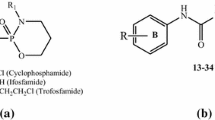Abstract
MP2 and B3LYP calculations are used to predict the most favorable site of temozolomide toward BH3 and BF3 which are classical Lewis acids. Binding energies, charge transfers, and bond length perturbations of the temozolomide in various complexes indicate that the N12 atom is the preferred attack site for BH3, while BF3 prefers the O17 atom. The interactions are quite strong, as much as 100 kJ/mol for BH3 and more than 60 kJ/mol for BF3. The molecular electrostatic potential surrounding temozolomide is most negative around the O atoms, which is unable to explain the energetic order of binding of the Lewis acids.






Similar content being viewed by others
References
Hvizdos KM, Goa KL (1999) Temozolomide. CNS Drugs 12:237–243
Jacinto FV, Esteller M (2007) MGMT hypermethylation: a prognostic foe, a predictive friend. DNA Repair 6:1155–1160
Gilbert MR (2006) New treatments for malignant gliomas: careful evaluation and cautious optimism required. Ann Intern Med 144:371–373
Jakubowicz-Gil J, Langner E, Badwiul D, Wertel I (2013) Silencing of Hsp27 and Hsp72 in glioma cells as a tool for programmed cell death induction upon temozolomide and quercetin treatment. Toxicol Appl Pharm 273(3):580–589
Jakubowicz-Gil J, Langner E, Wertel I, Piersiak T, Rzeski W (2010) Temozolomide, quercetin and cell death in the MOGGCCM astrocytoma cell line. Chem Biol Interact 188:190–203
Houghton PJ, Stewart CF, Cheshire PJ, Richmond LB, Kirstein MN, Poquette CA, Tan M, Friedman HS, Brent TP (2000) Antitumor activity of temozolomide combined with irinotecan is partly independent of O 6-methylguanine-DNA methyltransferase and mismatch repair phenotypes in xenograft models. Clin Cancer Res 6:4110–4118
Denny BJ, Wheelhouse RT, Stevens MF et al (1994) NMR and molecular modeling investigation of the mechanism of activation of the antitumor drug temozolomide and its interaction with DNA. Biochemistry 33:9045–9051
Schuster P, Zundel G, Sandorfy C (eds) (1976) The hydrogen bond. recent developments in theory and experiments. North-Holland Publishing Co, Amsterdam
Schuster P (1984) Hydrogen bonds. Springer, Berlin
Jeffrey GA, Saenger W (1991) Hydrogen bonding in biological structures. Springer, Berlin
Scheiner S (1997) Hydrogen bonding. a theoretical perspective. Oxford University Press, New York
Gilli G, Gilli P (2009) The nature of the hydrogen bond. Oxford University Press, Oxford
Wieczorek R, Dannenberg JJ (2003) H-bonding cooperativity and energetics of α-helix formation of five 17-amino acid peptides. J Am Chem Soc 125:8124–8129
Alabugin IV, Manoharan M, Peabody S, Weinhold F (2003) The electronic basis of improper hydrogen bonding: a subtle balance of hyperconjugation and rehybridization. J Am Chem Soc 125:5973–5987
Hernández-Soto H, Weinhold F, Francisco JS (2007) Radical hydrogen bonding: origin of stability of radical–molecule complexes. J Chem Phys 127:164102–164110
DelBene JE, Alkorta I, Elguero J (2011) An ab initio study of cooperative effects in ternary complexes X:CNH: Z with X, Z=CNH, FH, ClH, FCl, and HLi: structures, binding energies, and spin–spin coupling constants across intermolecular bonds. J Phys Chem Chem Phys 13:13951–13961
Thakur TS, Kirchner MT, Bläser D, Boese R, Desiraju GR (2011) Nature and strength of C–H···O interactions involving formyl hydrogen atoms: computational and experimental studies of small aldehydes. Phys Chem Chem Phys 13:14076–14091
Lee CT, Yang W, Parr RG (1988) Development of the Colle–Salvetti correlation-energy formula into a functional of the electron density. Phys Rev B 37:785–789
Kasende OE, Matondo A, Muzomwe M, Muya JT, Scheiner S (2014) Interaction between temozolomide and water: preferred binding sites. Comput Theor Chem 1034:26–29
Kasende OE, Muya JT, Broeckaert L, Maes G, Geerlings P (2012) Theoretical study of the regioselectivity of the interaction of 3-methyl-4-pyrimidone and 1-methyl-2-pyrimidone with Lewis Acids. J Phys Chem A 116:8008–8014
Pearson RG (1968) Hard and soft acids and bases. Part 1 fundamental principles. J Chem Educ 45:581–587
Becke AD (1993) Density-functional thermochemistry. III. The role of exact exchange. J Chem Phys 98:5648–5662
Gutowski M, van Duijneveldt van de Rijdt JGCM, van Lenthe JH, van Duijneveldt FB (1993) Accuracy of the Boys and Bernardi function counterpoise method. J Chem Phys 98:4728–4738
Latajka Z, Scheiner S (1987) Primary and secondary basis set superposition error at the SCF and MP2 levels: H3N–Li+ and H2O–Li+. J Chem Phys 87:1194–1204
Boys SF, Bernardi F (1970) The calculation of small molecular interactions by the difference of separate total energies. Some procedures with reduced errors. Mol Phys 19:553–566
Bonaccorsi R, Scrocco E, Tomasi J (1970) Molecular SCF calculations for the ground state of some three-membered ring molecules: (CH2)3, (CH2)2NH, (CH2)2NH2 +, (CH2)2O, (CH2)2S, (CH)2CH2, and N2CH2. J Chem Phys 52:5270–5284
Dennington R, Keith T, Millan J (2009) GaussView, version 5. Semichem. Inc., Shawnee Mission
Frisch MJ, Trucks GW, Schlegel HB, Scuseria GE, Robb MA, Cheeseman JR, Scalmani G, Barone V, Mennucci B, Petersson GA et al (2009) Gaussian 09, revision A.02. Gaussian, Inc, Wallingford
Chemcraft, Grigoriy A. Andrienko. http://www.chemcraftprog.com
Grabowski SJ (2015) π-hole bonds: boron and aluminum Lewis Acid centers. ChemPhysChem 19:1470–1479
Acknowledgments
The authors thank Mireille Bilonda Kabuyi of the University of Venda, Republic of South Africa, for fruitful collaboration.
Author information
Authors and Affiliations
Corresponding author
Additional information
This paper is dedicated to Professor Magdolna Hargittai on the occasion of her 70th birthday.
Rights and permissions
About this article
Cite this article
Kasende, O.E., Muya, J.T. & Scheiner, S. Regioselectivity of the interaction of temozolomide with borane and boron trifluoride. Struct Chem 26, 1359–1365 (2015). https://doi.org/10.1007/s11224-015-0640-6
Received:
Accepted:
Published:
Issue Date:
DOI: https://doi.org/10.1007/s11224-015-0640-6




